St. Mark's in-the-Bowery
Introduction
Text-to-speech Audio
Images
St. Mark's in-the-Bowery church (image from Gotham Trails)
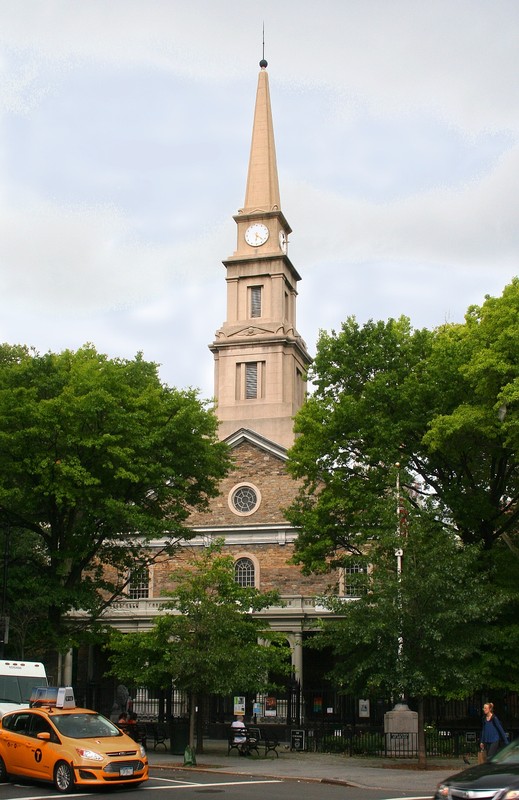
St. Mark's, early 1840s, by Lamson (image from Ephemeral New York)
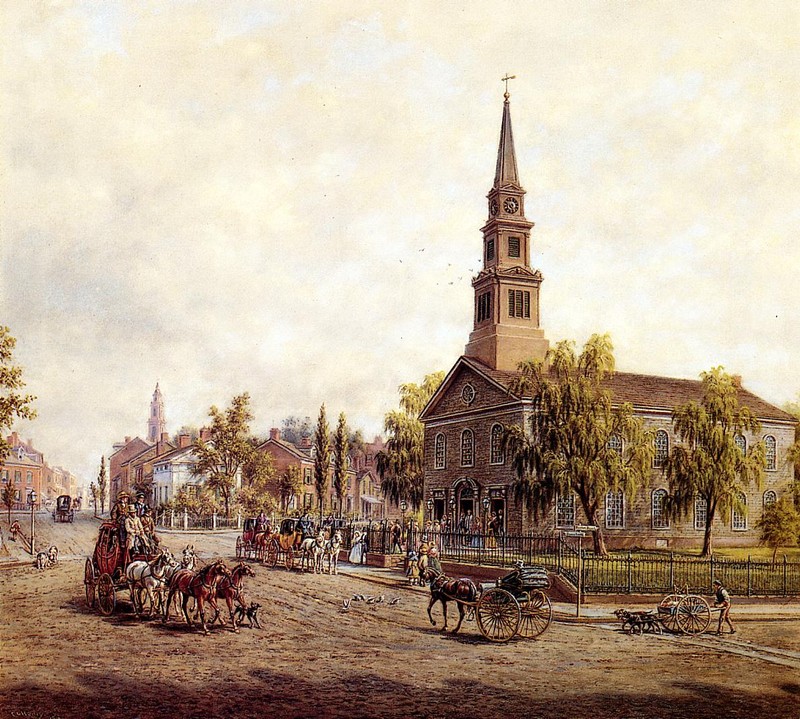
St. Mark's, 1853 (image from Ephemeral New York)
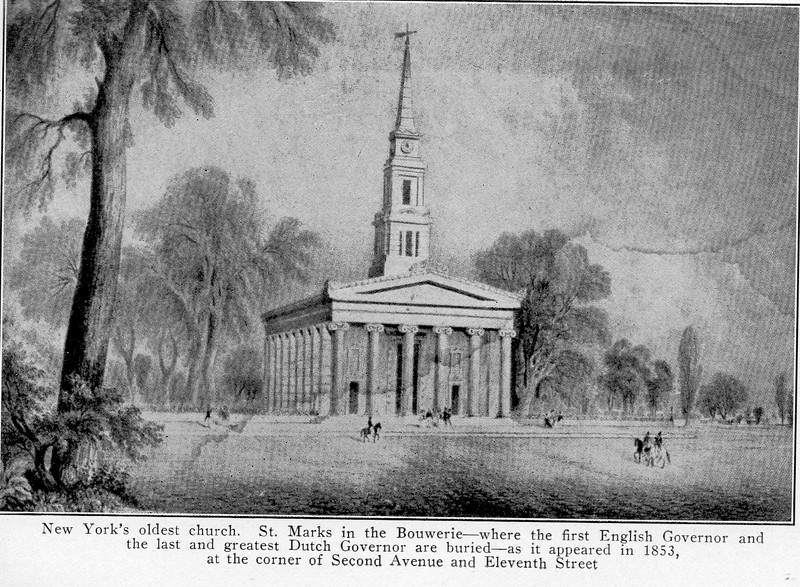
Interior of St. Mark's in-the-Bowery (image from lilinator.com)
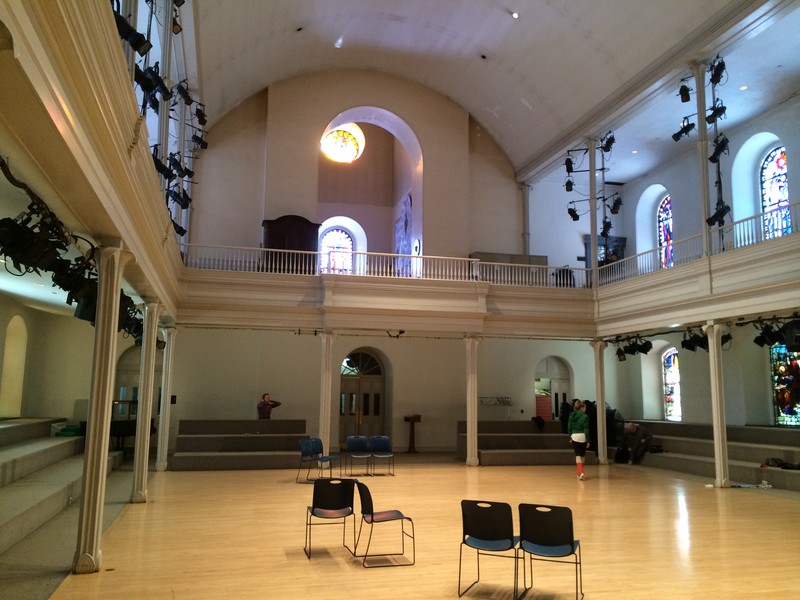
Historic Marker for St. Mark's in-the-Bowery (image from Historic Markers Database)
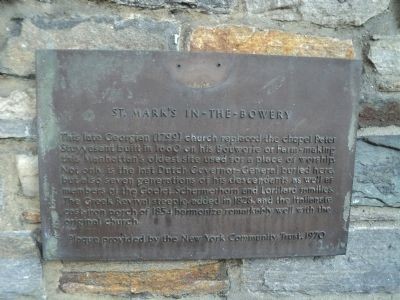
Grave of Petrus Stuyvesant at St. Mark's in-the-Bowery (image from Historic Markers Database)
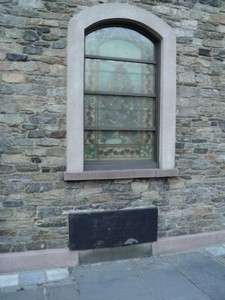
Grave marker of Petrus Stuyvesant (image from Historic Markers Database)
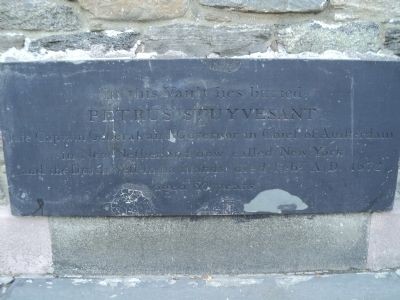
Peter Stuyvesant memorial bust at St. Mark's in-the-Bowery (image from Historic Markers Database)
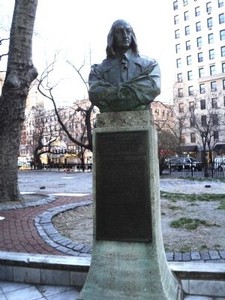
Peter Stuyvesant monument inscription (image from Historic Markers Database)
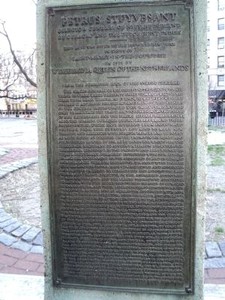
Daniel D. Tompkins memorial at St. Mark's in-the-Bowery (image from Historic Markers Database)
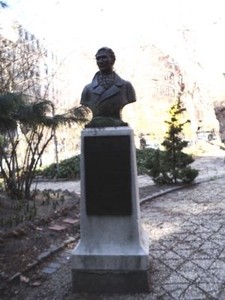
Grave of Daniel D. Tompkins at St. Mark's in-the-Bowery (image from Historic Markers Database)
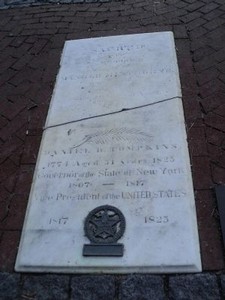
Backstory and Context
Text-to-speech Audio
After the death of Peter Stuyvesant in 1672, he was buried in a vault beneath his Dutch Reform Chapel in the Bowery. His great-grandson, Peter Stuyvesant II, requested in 1793 that Trinity Church rebuild the family chapel on the site of the vault. St. Mark's in-the-Bowery was established as the first New World Episcopal Parish independent of Trinity Church, with the legal assistance of Trinity attorney and (later) United States President Alexander Hamilton. Construction began in 1795, under the direction of architect and stonemason John McComb, Jr. The sanctuary is a Georgian-style fieldstone structure, with later additions by the architectural firm of Ithiel Town and Martin E. Thompson (who designed the steeple, 1828; renovated the interior, 1836; and replaced the original square balcony pillars with Egyptian Revival columnns, 1839); by John C. Tucker (who designed the stone portion of Parish Hall, 1835); by James Renwick, Jr. (who designed the brick portion of Parish Hall, 1861), and by architect James Bogardus (who designed the cast-iron portico in the 1850s). St. Mark's in-the-Bowery was attended by prominent families of the early 1800s, many of whom were buried in the churchyards. Burials include two Mayors of New York City, Gideon Lee and Philip Hone, as well as Peter Stuyvesant himself and Daniel Tompkins (namesake of nearby Tompkins Square, Vice President of the United States under Monroe, and former Governor, responsible for abolishing slavery in New York State). The 1876 burial of one prominent parishioner, department store entrepreneur A. T. Stewart, was disturbed when grave robbers stole his body on November 6, 1878, holding it for ransom for three years before the widow finally recovered it in 1881.
Rector William Norman Guthrie brought the arts to St. Mark's in-the-Bowery in the 1920s, sponsoring a five-woman Eurythmic Dance performance which scandalized many. Nonetheless, Guthrie supported visual arts, theater, architecture, poetry, and dance in the East Village. Famous figures who appeared at St. Mark's since the 1920s include Isadora Duncan, Martha Graham, Merce Cunningham, Ruth St. Denis, Edna St. Vincent Millay, Walter Houston, Frank Lloyd Wright, Kahil Gibran, W.H. Auden, Sam Shepard, Allen Ginsberg, Meredith Monk, William Carlos Williams, Amy Lowell, Carl Sandburg, Patti Smith, Jim Carroll, Andy Warhol, and Richard Foreman. J. C. Michael Allen, Guthrie's successor as rector, believed that Civil Rights, theology, and art were interrelated, and St. Mark's became a progressive social and cultural center for the East Village neighborhood, supporting immigrant, labor, and civil rights. It served as a meeting place for the Black Panthers, Young Lords, and the first lesbian healthcare clinic. In 1966, the St. Mark's Poetry Project was established; a year later, off-off-Broadway theater company Theater Genesis began under Ralph Cook and Sam Shepard; and Barbara Dilley and Larry Fagin started the Danspace Project in 1974. In 1978, a fire necessitated the restoration of the church. Local architect Harold Edelman oversaw the project, and the St. Mark's Historic Landmark Fund was established, with many contributions by poets and theater artists. St. Mark's also hosts the Incubator Arts Project and co-sponsors the annual Summer Jazz Festival.
Historic Marker Inscriptions:
St. Marks-in-the-Bowery
This late Georgian (1799) church replaced the chapel Peter Stuyvesant built in 1660 on his Bouwerie or Farm - making this Manhattan’s oldest site used for a place of worship. Not only is the last Dutch Governor-General buried here, but also seven generations of his descendants as well as members of the Goelet, Schermerhorn and Lorillard families. The Greek Revival steeple, added in 1828, and the Italianate cast-iron porch of 1854 harmonize remarkably well with the original church. / Erected 1970 by New York Community Trust.
Grave of Petrus Stuyvesant
In this Vault lies buried / Petrus Stuyvesant / late Captain General and Governor in Chief of Amsterdam / in New Netherland now called New York / and the Dutch West-India Islands, died Feby. A.D. 1672 / aged 80 years.
Bust of Petrus Stuyvesant
Director General of Niev Nederland / of Curacao and the Dutch West Indies / This bust was given to the people of New York in trust of Saint Mark’s-in-the-Bowerie in 1915 by Wilhelmina Queen of the Netherlands / From the Commissie Boek of the States General / The States General of the United Netherlands to all those to whom these presents shall come or who shall hear them read, health. Be it known whereas we have deemed it advisable for the advancement of the affairs of the General Incorporated West India Company not only to maintain the trade and population on the coast of New Netherland and the places situate thereabout, also the islands Curacao, Buenaire, Aruba, and their dependencies, which have hitherto been encouraged thither from this country, but also to make new treaties and alliances with foreign princes and to inflict as much injury as possible on the enemy in his forts and strongholds as well by sea as by land for which purpose it becomes necessary to appoint a person director we therefore, confiding in the probity and experience of Petrus Stuyvesant formerly entrusted with our affairs in, and the government of, the aforesaid island of Curacao and the places thereon defending, we being well pleased with his services there, have commissioned and appointed, by these presents do commission and appoint the said Petrus Stuyvesant director in the aforesaid countries of New Netherland, and the places thereunto adjoining, together with the afore-mentioned islands of Curacao, Buenaire, Aruba, and their dependencies, to administer with the council as well now as hereafter appointed with him the said office of director both on water and on land and in said quality to attend carefully to the advancement, promotion, and preservation of friendship alliances, trade and commerce; to direct all matters appertaining to traffic and war, and to maintain, in all things there, good order for the service of the United Netherlands and the General West India Company to establish regularity for the safeguard of the places and forts wherein, to administer law and justice as well, civil and criminal, and moreover to perform all that concerns his office and duties in accordance with the charter and the general and particular instructions herewith given, and to be hereafter given him, as a good and faithful director is bound and obliged by his oath in our hands to do which done we therefore order and command all other officers, common soldiers, together with the inhabitants and natives residing in the aforesaid places as subjects and all whom it may concern, to acknowledge and obey the said Petrus Stuyvesant as our director in the countries and places of New Netherland and in the islands of Curacao, Buenaire, Aruba and their dependencies, and to afford all help, countenance and assistance in the performance of these things as we have found the same to be for the advantage of the Company done in our assembly at the Hague, on the XXVIII July 1646 / Erected 1915 by Wilhelmina Queen of the Netherlands
Daniel D. Tompkins Marker
A Great American / Son of a Revolutionary patriot / Born in Fox Meadows (Now Scarsdale) N.Y. June 21, 1774 / Died in Tompkinsville, Staten Island N.Y. June 11, 1825 / Governor of New York State 1807-1817 — Vice President of the United States 1817-1825 / Military Commander of the Third Military District October 14, 1814 / Governor Tompkins sustained the credit of the United States Government, with his personal funds, at a time when the banks of New York refused to loan to the government on its notes, without his endorsement. A graduate of Columbia College 1795. A member of the state constitutional convention 1821. / President Madison handed him the portfolio of Secretary of State, which he refused. Founder of the New York State Historical Society and Chancellor of the University of New York. / Daniel D. Tompkins held not only the office of governor of the state but was paymaster quartermaster, commissary, and general distributing agent of the State of New York and the United States. / Erected by The United States Daughters of 1812 of the State of New York / November 2, 1939
Daniel D. Tompkins Grave
Sacred to the memory of Mangle Minthorne / who departed this life on the 20th day of April 1821 / aged 83 years 8 months and 6 days / Daniel D. Tompkins / 1774 – 1825 / aged 51 years / Governor of the State of New York 1807 – 1817 / Vice President of the United States 1817 – 1825
